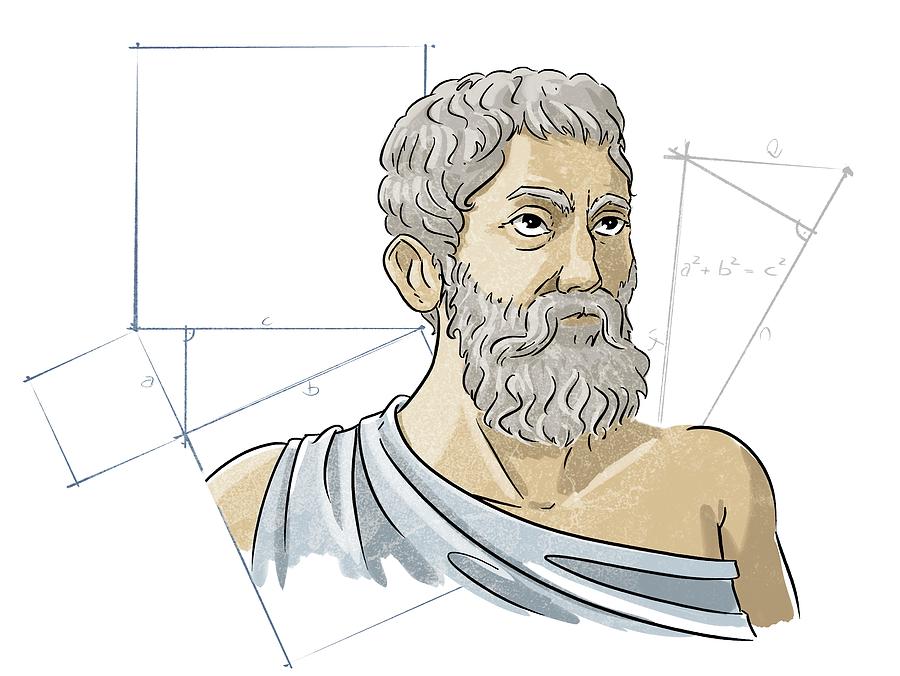 Illustration of Pythagoras (Source: pixels.com)
Illustration of Pythagoras (Source: pixels.com)
Pythagoras, a Greek mathematician and philosopher who lived around 570–495 BC, is renowned as a legendary figure who not only carved his name in the history of mathematics but also transformed the way we understand the world through numbers and shapes. The theorem that bears his name has become a fundamental pillar in geometry, providing the foundation for many scientific discoveries and techniques that we know today.
Born on the island of Samos, Greece, Pythagoras is believed to have spent most of his life in Egypt and Babylon, where he was exposed to advanced mathematical and astronomical knowledge. Although there are no direct written records from Pythagoras, his teachings and philosophies were widely disseminated through his followers who formed the Pythagorean school. This school not only taught mathematics but also philosophy, music, and a strong moral discipline (Katz, 1998).
Pythagoras and his followers developed the idea that numbers have deep meanings and important relationships with the universe. They believed that all aspects of life could be explained through numbers and harmonious ratios. In this quest, Pythagoras sought to understand the relationship between numbers and geometric shapes, which led to the emergence of the famous theorem that is now part of the mathematics curriculum worldwide (Dunham, 1990).
The Pythagorean theorem reveals that in every right triangle, the relationship between the lengths of the triangle’s sides can be analyzed in a very interesting way. This theorem is not just a theoretical concept; it has become a practical tool used in various fields, ranging from architecture to engineering and physics (Heath, 1921).
Although Pythagoras is often identified with this theorem, similar concepts actually existed earlier in Mesopotamian and Indian cultures. However, Pythagoras and his followers provided the documentation and systematization that made this theorem easier to understand and apply, making it one of the main pillars of mathematics education for centuries (Struik, 1987).
Pythagoras’s legacy lies not only in his geometric theorem but also in his profound philosophical influence. His thoughts on the relationship between numbers, music, and harmony impacted many great thinkers in the future, including Plato and Aristotle. Pythagoreanism, the teachings produced by his school, emphasized the importance of self-development and morality through education in mathematics and science (Dunham, 1990).
The influence of Pythagoras can still be seen today in mathematics education. The theorem that bears his name is taught in schools around the world and continues to be an important part of the curriculum. The concepts introduced by Pythagoras and his followers have laid the groundwork for many branches of mathematics, such as trigonometry and algebra, and continue to inspire new generations of mathematicians and scientists.
Pythagoras is one of the most influential figures in the history of mathematics. With a legacy that has changed the way we understand geometry and the world around us, he shows us that behind every number and shape, there is beauty and order that underlies reality. Pythagoras teaches us that mathematics is not just about numbers, but also about discovering harmony in the structures and patterns that surround us.
Keywords: Pythagoras, Pythagorean Theorem, Geometry, Pythagorean School, Philosophy, History of Mathematics
References
Pythagoras. (n.d.). In Stanford Encyclopedia of Philosophy. Retrieved from https://plato.stanford.edu/entries/pythagoras/
Heath, T. L. (1921). A History of Greek Mathematics. Oxford University Press.
Katz, V. J. (1998). A History of Mathematics: An Introduction. Addison-Wesley.
Dunham, W. (1990). Journey through Genius: The Great Theorems of Mathematics. John Wiley & Sons.
Struik, D. J. (1987). A Concise History of Mathematics. Dover Publications.
 Author: Silvina Rosita Yulianti
Author: Silvina Rosita Yulianti
